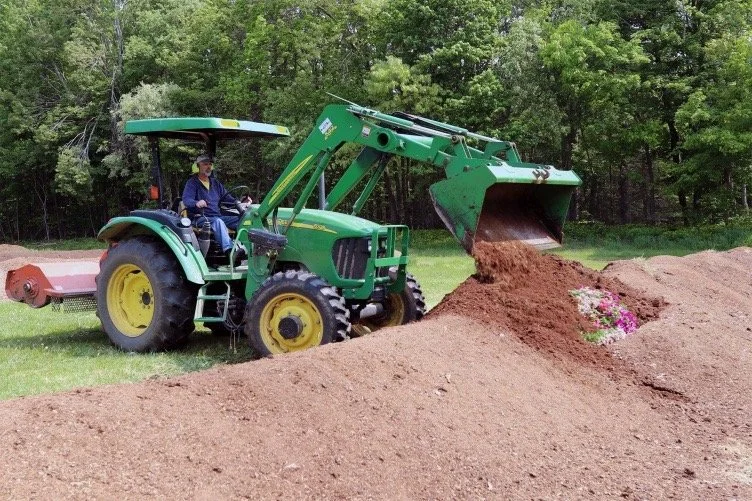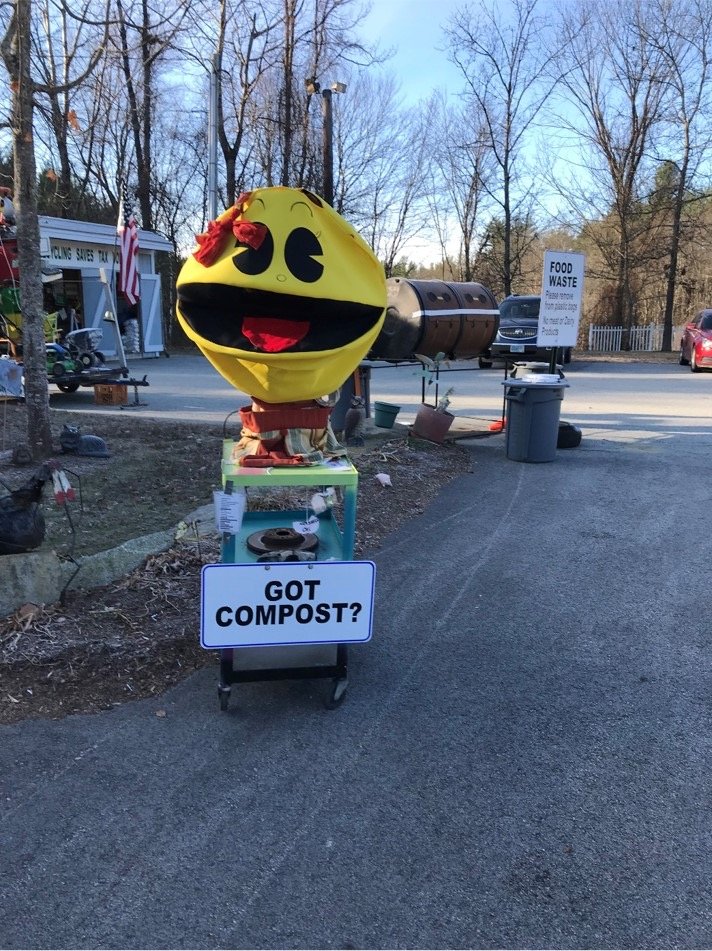By Michael McCord, Granite State News Collaborative
Joan Cudworth had a burst of show-and-tell inspiration in the summer of 2018.
Cudworth, who was then solid waste supervisor for the town of Hollis, came to the select board meeting with a partial solution to tackle the rising costs of trash disposal. She wanted town leaders to fast-track a pilot program to cut down on the amount of food waste being sent to landfills.
“We were looking to reduce trash and taxes,” Cudworth said. “I knew it was a small step. but it was important to get buy-in from the select board.” Cudworth composed at her home and learned how little trash remained after the composting and recycling. She came to the meeting with a transparent, medium-sized bowl containing a week’s worth of food scraps from her house – lettuce, strawberry tops, radish tops, fruit scrapes, rice, egg shells, cucumber and potato peels. The show and tell worked.
Packalina, Hollis transfer station composting mascot
“I remember people were fascinated by the possibilities,” Cudworth said. The select board immediately approved money for two Department of Public Works employees to attend the Maine Compost School. By 2019, the pilot program was up and running and collecting around 50 pounds of food waste a week (local schools were already running their own compost programs) at the transfer station. Residents who stopped by were greeted by a composting mascot named “Packalina.”
Cudworth, who became the public works director in 2020, says the total of food waste collected now tops 200 pounds weekly. That may not seem like a lot but, like compound interest, it adds up – to 10,400 pounds annually, which means that the town of about 8,000 residents has diverted more than five tons of food waste from landfills while decreasing climate-harming methane production from food waste fermenting in landfills.
“We are still experimenting and still learning. We don’t know how many are coming to the transfer station or how many residents know about the program,” Cudworth.
Food waste a state priority
Paige Wilson, waste reduction and diversion planner at the New Hampshire Department of Environmental Services
Paige Wilson, waste reduction and diversion planner at the N.H. Department of Environmental Services, has been busier than normal since the state passed its first food waste ban last summer. The law will go into effect on Feb. 1, 2025. It is focused on entities that generate as much as one ton of food waste a week. That food waste will be prohibited from being sent to landfills. Over the past decade, lawmakers in the nearby states of Vermont, Maine, Massachusetts, Rhode Island and Connecticut have enacted varying levels of food waste disposal bans.
“Food waste is something we all have in common, and composting is a low-hanging-fruit solution,” Wilson said.
It’s also a solution that needs a major expansion of infrastructure. Wilson is the education outreach and planning person, and her job is to assist commercial and municipal organizations, so she sees firsthand that food waste diversion in New Hampshire needs a major expansion of public and private infrastructure for a more sustainable path.
“There are a lot of factors that go into a sustainable (food waste diversion) program: budgeting, staffing, feasible space” for larger-scale composting, she said.
Another issue will be addressed in the coming year. The U. S. Environmental Protection Agency estimated that state residents put more than 180,000 tons of food waste into landfills — about 24 percent of all waste. But no on-ground studies have been done to better approximate the actual amount. Wilson said more comprehensive studies have been funded and will be launched – by literally sorting through trash.
“We’ve never had a state (food waste) characterization study on the amount of food. We will do one now by literally hand-sorting through 250 pounds of waste to get data,” Wilson said. Because the state has made food waste a priority, a diverse constituency of summer camps, municipalities, hospitals, schools, hospitals, nursing homes and any organizations that generates food waste has heard the call and reached out to find out what they can do.
“What you are seeing is a huge resurgence of interest in solid waste and recycling,” said Rep. Karen Ebel, D-New London, the prime sponsor of the bipartisan food waste ban legislation and chair of the state’s Solid Waste Working Group. “I feel like we are making progress.”
In particular, she said, it was a positive step that 50 percent ($500,000) of the state’s Solid Waste Municipal Fund appropriated by the legislature to food diversion efforts will include staffing and grants.
The cost of infrastructure
It’s not easy to come up with a solid estimate on the cost of building out a food waste recovery infrastructure.
According to Paige Wilson, “New Hampshire will need infrastructure investments all along the food recovery chain, but the costs vary so much depending on where you’re at in the chain. The price tag for buying a refrigerator at a food bank looks different than the costs of purchasing equipment at a composting facility. I’d say it’s going to take millions of dollars to build the needed infrastructure across New Hampshire, in order to reach our disposal reduction goals set in statute (25 percent reduction in landfill solid waste by 2030 and 45 percent reduction by 2050).”
Reagan Bissonnette, executive director of the Northeast Resource Recovery Association, agreed that it will cost millions, but patience, innovation and more legal requirements will be needed.
Reagan Bissonnette, Executive Director of the Northeast Resource Recovery Association
“Infrastructure money is not enough. Other states have found that without a landfill ban on some food waste in place, it’s difficult to have enough food waste supply to make an investment in infrastructure financially viable in the long term,” she said. “An example is the Waste Management Core facility in Massachusetts. Even with a statewide food waste ban in place, it took longer than they expected to get enough supply from businesses and others to get the facility operating at capacity.”
Vermont, said Wilson, is “a New England state to learn from because they’re in a territory right now that is unknown to the rest of us. A statewide food waste disposal ban that applies to everyone comes with a lot of learning curves, new systems, and innovation.”
Over the years, said Bissonnette, Vermont has implemented tiered food waste disposal bans over time. They started with banning disposal of food waste from large generators of waste (like hospitals and universities), then slowly lowered the generation amount until all food waste, even from residential homes, cannot be landfilled.”
Making composting work
At its Kingman Farm research facility, the University of New Hampshire in Durham has one of the largest compost-creating operations in the state, and it has been operating since the mid-1990s. Colleen Stewart at the New Hampshire Food Alliance (which is part of the UNH Sustainability Institute), said UNH had one of the first campus compost programs in the country. In 2023, UNH dining halls sent 386,260 pounds of food pulp to Kingman Farm composting rows, which creates nutrient-rich soil. That soil is used by students to create crops for some of the produce served at UNH dining halls.
In a June 2023 UNH Today article detailing the composting program, Anton Bekkerman, director of the New Hampshire Agricultural Experiment Station at Kingman Farm, said “the program here at UNH really highlights that even without large investments into infrastructure and labor that a composting program can be implemented by the Granite State’s smallest towns and village to ultimately reduce waste and provide a nutrient-rich additive to gardens and farms.”
The topic of food waste diversion was front and center during two days of workshops in April hosted by the Northeast Resource Recovery Association. Reagan Bissonnette, NRRA’s executive director, said her Epsom-based organization has been targeting food waste diversion for the past five years, in addition to more than four decades of recycling educational efforts. She said about 50 people from municipalities and businesses from across the state attended the four workshops, which were co-hosted by the N.H. Department of Environmental Services and the Maine Compost School.
Bissonnette said among the many points covered at the workshops – which were free, courtesy of a U.S. Department of Agriculture grant – participants learned a few surprising truths about food waste:
Most wasted food is generated by households (almost 43 percent), not manufacturers or retailers.
In 2022, roughly 38 percent of the U.S. food supply went unsold or uneaten.
Preventing wasted food has a bigger positive environmental impact than composting wasted food.
Composting 101: Participants at recent NRRA food waste diversion workshop
“One town concluded that they need to send a mailer to their entire town to effectively get out the word about their existing composting program,” she said.
The topic of food waste diversion will be the focus of a keynote panel at the NRRA annual conference in Concord in June. Later this year, she said, NRRA will conduct its first bus tour focused on waste diversion programs at various landfills and transfer stations.
Citizen involvement
Not unlike Joan Cudworth in Hollis, Paul Karpawich was inspired to do something positive to tackle the climate change crisis as a lone citizen.
“I feel that people can be overwhelmed about climate change,” said Karpawich, who had migrated north from Massachusetts and was living in southern New Hampshire town of Brookline when he began looking at the bigger picture of long-term sustainability. The veteran of the high-tech industry said he “kind of gravitated” to food waste diversion in part because “food waste is so prevalent in our society,” and it was something everybody could do.
Karpawich had no title and few contacts, but he persevered, and in 2022 created the New Hampshire Food Waste Diversion and Sharing Initiative with the help of small grants from the World Wildlife Fund and U.S. Department of Agriculture. The program is a collaborative effort between individuals, schools and towns to develop best practices that reduce food waste and prevent it from going to landfills.
Evan Ford, UNH Kingman Farm manager with compost pile in 2023 (UNH courtesy photo)
More importantly, he focused on elementary and secondary school students to get them involved early. “By taking small concentrated steps this can be a catalyst for students, schools and towns to create a long-lasting paradigm shift for a transition to a more sustainable future,” he said. He has seen the impact of schools institutionalizing their efforts, with a few school boards allocating budget funds for the pickup of composting loads.
The initial success of the program has led to more grants and increased ability to jump-start food waste diversion programs at schools. The initiative has spread from the elementary school in Hollis, the first participant, to schools in Northwood, Bethlehem, Hopkinton (where Karpawich now lives) and others. He said the educational aspects of the program (math, science and environmental awareness) have been matched by a remarkable level of dedication by students who get involved.
“When kids do this, they are very present, not looking at their phones. I have seen at the elementary and high school levels that they become very passionate and take ownership of the programs at their schools,” he said.
Find out more: NRRA offers a Waste Reduction and Diversion Toolkit, a list and links to almost 20 municipalities offering food diversion and composting programs, and a list of farms and pick up services serving New Hampshire.
The EPA is awarding between $10 million and $20 million in Environmental and Climate Justice Community Change grants for multi-faceted projects addressing a range of pollution, climate change, and other priority issues, including food waste diversion. This application period goes through November.
These articles are being shared by partners in the Granite State News Collaborative. For more information, visit collaborativenh.org.





